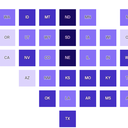Red states aren't prepared for a post-Roe baby boom

The red states poised to ban or severely limit abortion already tend to have limited access to health care, poor health outcomes and fewer safety net programs in place for mothers and children.
Why it matters: If the U.S. Supreme Court overturns Roe v. Wade, as it's expected to, the ensuing increase in births will likely leave families in tough circumstances and strain systems that are already hanging by a thread.
"What we're facing as a country is hundreds of thousands of births, probably disproportionately located in the states that have been most limited in what they do for pregnant women, infants and children. So this is the great paradox that we are dealing with," said Sara Rosenbaum, a health law and policy professor at George Washington University.
- "We have not ever designed these programs for a world without Roe," she added. "You need a child welfare system, the likes of which we've never seen.”
Where it stands: Experts say there's already a growing shortage of obstetricians.
- In 2020, more than 2 million women of childbearing age lived in counties that had no hospital offering obstetric care, no birth center and no obstetric provider, according to a report by March of Dimes.
- Millions more lived in areas with limited access to care.
- Red states in the middle of the country — many of which will automatically ban abortion if Roe is overturned — are particularly likely to have a high number of maternity care deserts.
States with more abortion restrictions also tend to have higher maternal mortality rates and worse health care outcomes generally.
- A recent AP analysis found that states with the strictest abortion laws are also some of the most difficult places to have and raise healthy children.
- Many of the states with abortion bans have also refused to expand Medicaid, meaning low-income women in those states have limited access to health care and thus may be in poor health before becoming pregnant.
By the numbers: In 2019, there were more than 600,000 abortions in the U.S., according to the CDC. About 3.75 million babies were born in the same year.
Between the lines: Experts say abortion bans would also likely put more pressure on U.S. foster and adoption systems.
- More than 600,000 children were served by the foster care system at some point in the 2020 fiscal year, according to HHS.
- As of September 2020, more than 100,000 of them were waiting to be adopted, and nearly 60,000 were adopted through a public agency that year.
- An increase in births that would have otherwise not occurred "almost certainly means more foster children," said Richard Shannon, chief quality officer for Duke Health. And while the foster care system is "a vital social service, it is in desperate need of further improvement and will only be stressed by an increase in pregnancies and live births among moms who can't take care of their kids."
What we're watching: The statistics around children who live in traumatic or volatile circumstances are grim.
- "We know from focus on health outcomes that kids born into poverty, kids born into unstable social circumstances, tend to have higher incidence of early onset chronic diseases," Shannon said. "We also know that when those children are raised in unstable circumstances and have to be cared for in foster care, the outcomes there are really sobering."